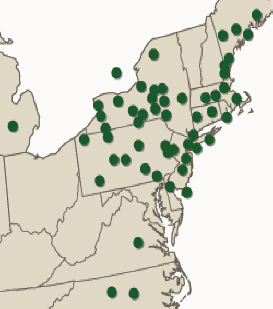Habitat & Geography
 Photinus ignitus, and fireflies in general, are found on every
continent except for Antarctica (Cratsely, 2004). Photinus ignitus
is most commonly found in the northeastern part of the United States (Eisner
et. al., 1978). The habitat that is best for Photinus ignitus
is a warm, humid environment. With that being said, Photinus
ignitus is most active in the summertime, typically in mid June
until late July (Museum of
Science, 2013). Photinus ignitus are also found in
forests and fields near marshes, rivers, ponds, and streams. A wet
or moist environment is critical for their survival (Firefly, 2013).
With fireflies living in this type of habitat, there is a wide variety of organisms that can
be found in that same environment. A few organisms that
coincide with Photinus ignitus are
deer ticks, squirrels,
mosquitos, beavers,
coyotes, and
white-tail deer. Photinus ignitus are not
found too often in the western United States, like in areas of
California. A reason behind this is that California is too
much of a dry area. Another reason is that other firefly
species that already live there out-compete Photinus ignitus for
resources (Lloyd, 2005).
Photinus ignitus, and fireflies in general, are found on every
continent except for Antarctica (Cratsely, 2004). Photinus ignitus
is most commonly found in the northeastern part of the United States (Eisner
et. al., 1978). The habitat that is best for Photinus ignitus
is a warm, humid environment. With that being said, Photinus
ignitus is most active in the summertime, typically in mid June
until late July (Museum of
Science, 2013). Photinus ignitus are also found in
forests and fields near marshes, rivers, ponds, and streams. A wet
or moist environment is critical for their survival (Firefly, 2013).
With fireflies living in this type of habitat, there is a wide variety of organisms that can
be found in that same environment. A few organisms that
coincide with Photinus ignitus are
deer ticks, squirrels,
mosquitos, beavers,
coyotes, and
white-tail deer. Photinus ignitus are not
found too often in the western United States, like in areas of
California. A reason behind this is that California is too
much of a dry area. Another reason is that other firefly
species that already live there out-compete Photinus ignitus for
resources (Lloyd, 2005).
There has been a decrease in the number of Photinus ignitus seen
in the eastern United States. The explanation behind this is
that there has been an increase in air, soil, water, and light
pollution, which affects their habitat and the larvae prey.
To find out more about the larvae prey go to our
Life History & Reproduction page. The increase of land development by humans also affects the
Photinus
ignitus in a negative way. There is a decrease in habitat
space for them to mate and lay their eggs. There has been a
decrease of water in the environments with ponds and streams drying
up. This has caused the Photinus ignitus population
to decrease. Photinus ignitus and many other species of
fireflies have their habitats being disrupted by water runoff
carrying higher levels of vehicle hydrocarbons, fertilizers,
poisons, and salt (Lloyd, 2005). This is critical because the
Photinus ignitus population has gone done in size each year.
in habitat
space for them to mate and lay their eggs. There has been a
decrease of water in the environments with ponds and streams drying
up. This has caused the Photinus ignitus population
to decrease. Photinus ignitus and many other species of
fireflies have their habitats being disrupted by water runoff
carrying higher levels of vehicle hydrocarbons, fertilizers,
poisons, and salt (Lloyd, 2005). This is critical because the
Photinus ignitus population has gone done in size each year.
Back to
Home
Read about
Form and Function
